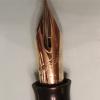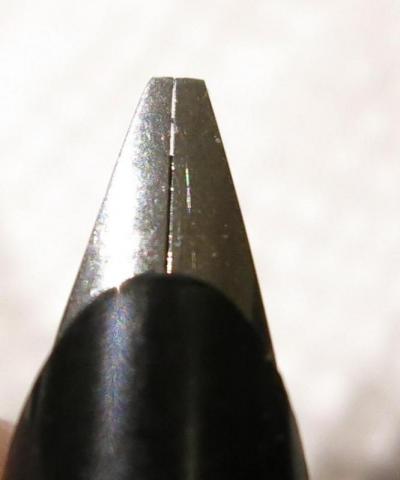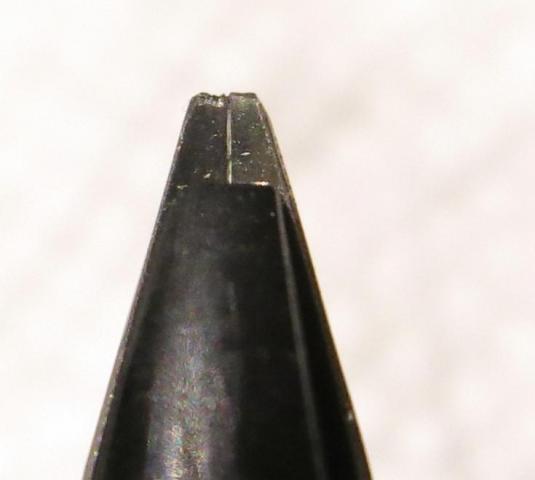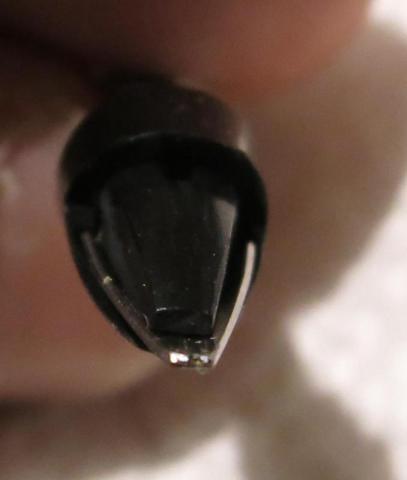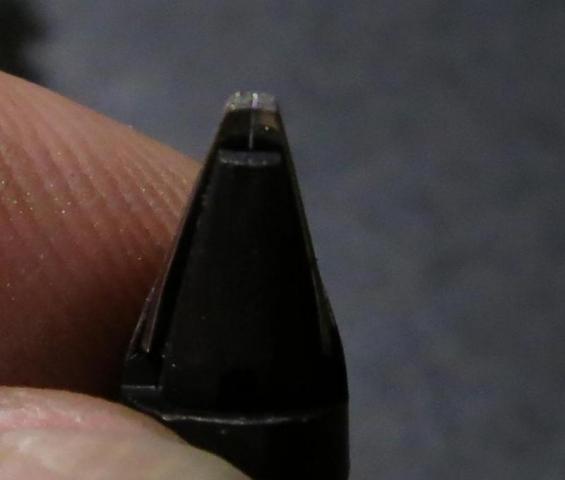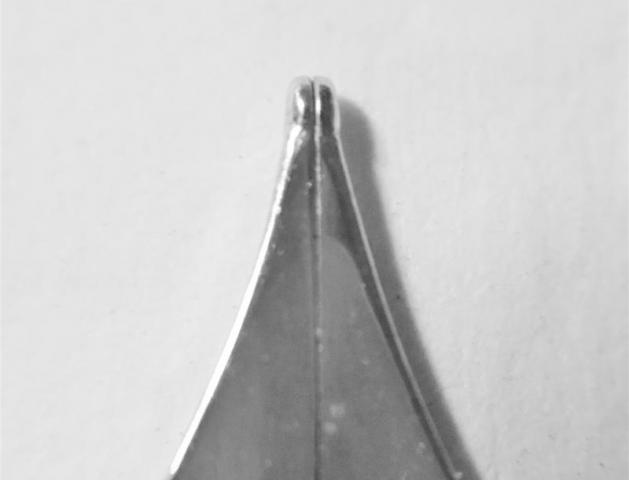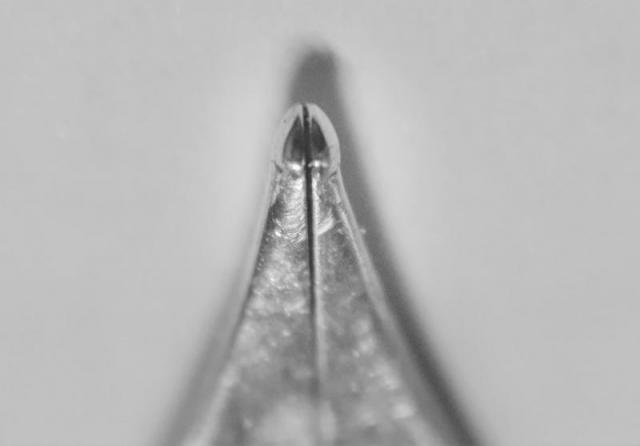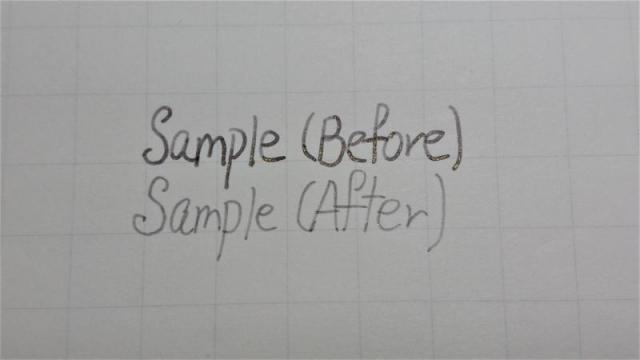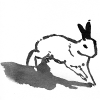Search the Community
Showing results for tags 'nib grinding'.
-
Interesting interview and look at his nib grinding setup. In the last couple of minutes he discussed holding the pen in different ways to change the line.
-

Where in Rome can I get a Parker 51 nib ground from Medium to Fine?
dysmedia posted a topic in Repair Q&A
Does anyone here know a shop or private nibmeister (nibmaestro?) in Rome who I can trust to grind a vintage Parker nib? I'm not even sure whether this is a good idea. It's a vintage Parker 51 Special with an absolutely perfect Medium nib (Octanium), but what I really need is a Fine. Is it sacrilege to have it ground down? Will it be as good as it is now? Am I better to simply swap it out? Semi-serious metaphysical question: It has sentimental value; does grinding a nib diminish the sentimental value of a pen? -
Nibs: Steel / Titanium / Gold / (Genius) Iridium
CapeWind posted a topic in Fountain & Dip Pens - First Stop
I found it quite interesting to see research on how (even the major pen manufacturers) are labelling their nibs. (In particular "Iridium/Genius Iridium") which often only carries a trace amount of iridium). I own several fountain pens (rabbit hole after all) but only a couple of them have gold tips. First, as a South African (one of the largest miners of gold) I can tell you that most of the advertising about the " investment value" of gold nibs is plain bunkum. Second, ever since grade school I've had the habit of pressing too hard on my pens. It's now become my writing style and a gold nib has just too much flex to stand up to that style. Since there doesn't seem to be too much of disclosure on just what our nibs are made of, what I'd like to know is if anyone here had actually worn through a nib? If so would you say it was wholly/predominantly. the nib quality or was it (as I would suspect) a mixture of writing style, paper quality, general maintenance? Please share!- 2 replies
-
- nib abuse
- nib options
-
(and 1 more)
Tagged with:
-
Hello and greetings to all of you! I was quite happy with my Pilot Varsity/V-Pen. But the only problem for me was with the nib being a very fat Japanese medium (even fatter than a JoWo medium). It was also very wet with its original ink contributing to fatness. Now 15 year old me was curious about grinding my Parker Urban nib to one size down to probably a fine or at least remove its baby's bottom. But the fear of ruining it forbade me to. Then it dawned upon me. I took my Varsity and sat down for an hour or so and reground that medium to almost a nice fine. How I did it? Here you go: 1)Took my mom's nail buffer and started running the nib on the coarsest side first for about 45 minutes to get it to a fine (Relax, it takes time on that thing. The reason I didn't grind it to an extra fine was the time). 2)Then after I got it to where I wanted, I smoothed out the nib from all sides making a consistent shape. 3)Then took a cup and smoothed the pen on its underside by drawing figure eights until I was happy. Now I am really proud of myself as this is the first nib grind I have done and achieved success with it. The Varsity writes beautifully with a fine consistent line with consistent ink flow wit Pelikan 4001 Royal Blue. Feel free to ask me anything! Thanks for reading, Adit Sreesh Kamath
- 9 replies
-
- nib grinding
- pilot
-
(and 4 more)
Tagged with:
-
Over the years, I've tried nib grinding and have destroyed quite a few of them in the process. But I've also gotten better Definitely not pro-level, but here are a few of my grinds. Writing samples to follow soon. I used a whetstone, and sandpaper to grind these. 1) Architect on Kanwrite Medium nib: 2) Needlepoint on a Wingsung 727 3) Stub on a Kanwrite broad Thank you for looking!
-
Almost all my fountain pen nibs have been custom-ground to the crisp cursive italic I favor for my everyday italic handwriting. So I am always happy to find a new nib technician who can grind a sweet-writing nib for me. Appelboom pens in The Netherlands has begun offering the nib grinding services of Anabelle Hiller. I have a first nib from her, and it is a gem. The nib started as a stock Kaweco (Bock) steel Broad. Anabelle ground it, as requested to a crisp cursive italic. No affiliation other than a happy customer. David
- 9 replies
-
- nib grinding
- nibmeister
-
(and 2 more)
Tagged with:
-
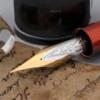
Successful Nib Adjustment With A Knife Sharpening Whetstone
trayvyz posted a topic in Of Nibs & Tines
I just received one of these in the mail. It's a 10x2.5x1 cm double sided whetstone intended for knife sharpening. It has two sides with two different grit: 5000 and 12000. The green side is made of corundum which is supposedly the next hardest material after diamond. I got it off ebay for about $7 and I have to say that I've already adjusted nibs on 3 different pens (including my brand new Wing Sung 618) and the results are very positive. I started with light, 8-shaped strokes on the 5000 side and then did the very fine adjustment on the 12000 side. My Wing Sung went from sharp nail to butter soft in a matter of minutes. I am very pleased with this item and I feel that it's going to be all I am going to need in my nib grinding tool set for quite some time. Have you ever tried this? -
I have two questions about grinding a medium nib to a fine (or at least finer). I've managed to bring a non-flex Noodler's nib that was very thick to a finer line, and though still very smooth it feels like I'm writing with a big round ball, but I can't understand why it feels that way (so I would know what to alter)... any ideas? I've also started grinding a Jinhao nib. Is narrowing the sides of the tip the only thing I should do? It already writes a bit thinner than before (and I've lost the smoothness because I slipped off the grindstone...) but I want it finer still. Simply put : what else should I pay attention to besides "shaving" off the sides of the tip and maybe softening the transition between sides and underside of the nib? Nothing to do with the topic but by the way, Jinhao nibs (x450) are too big/loose for Conklin Duraflex (oh that Omniflex...) feeds. Thanks for the help - what I found searching this forum was too vague for me to understand... Timo
-
The grand experiment is on. I have an extra Skyline nib which is hard as a nail. I am recontouring the underside, much like how Waterman flex nibs are ground (thinner at the edge, full thickness at where the two tines meet). I just want to give this nib a small amount of flex. This is baby steps for me before I go more dramatic. The pen it will rest in, is going through the final stages of a restore (the shellac which holds the sac in place is drying). Previously there was no flex or line variation with this nib (as tested before the restore effort). Tomorrow I will post the results. The victim is a Skyline Standard in black.
-
"Stub" nibs seem always (**) to be ground flat not only on the bottom and end, making the angle that contacts the paper and gives directional line variation, but also on the top which never (*) contacts paper. When customizing an ordinary ball-tipped nib to make a stub, why go through the extra step of grinding off the top? I know it is not necessary for writing to flatten the top/back of a round nib, nor of a CI: I have a cursive-italic nib, customized from a broad, that is an EF for writing upside-down, rather the opposite of flat. Yes, I know that a "stub" and a "cursive italic" are distinguished categories. If the distinction is relevant to my question, please elaborate on how. Otherwise not. And I also know that the "angle" I referred to above is eased or rounded on a stub nib. If that is relevant to my question, please elaborate on how. Otherwise not. I would rather not hear a bunch of guesswork answers. Those I can make up for myself. Please wait for someone who actually knows. Would it not be both less work to leave the backside of a stub round, and slightly beneficial in providing a (vey slight) extra bit of ink buffering very near the point of delivery? Why is it done? Thanks. (*) "never" in its regular use a a stub nib. The possibilities for using the reverse of a nib are interesting. That's a different set of questions I am not asking now. I just want to know why stubs have those possibilities ground off. (**) "seem always" because every stub nib I have examined, and every close-up photo of a stub nib I have seen, and the instructions I have read for grinding a stub, all show this feature. But I have not done a survey. If there are some stubs that do not have the back ground off, please show a picture. In any case my question remains for those that are ground off: Why? Thank you!
-
I heard from a local pen maker about the nib polishing using a waterstone (or sandstone) with higher grit numbers (10000 above). i know there commercial product there, polish pads with all possible grit numbers. But i want to try out the traditional way of working and improving nibs. anyone tried the stone polish method ?
-
Hi y'all, Got a Parker 45 recently and it had a broken nib, so last Sunday I figured that I might grind it like there's no tomorrow. After all, I had nothing to lose. (I was in a grinding mood anyway, as I sharpened three knives earlier that day.) Started with a diamond knife sharpener I had lying around, to shape the nib, and then followed with the entire gamut of micromesh. the most challenging part was to get a flat section out of a concave object (remember, the tip of the nib was missing). The pictures show the result of each step, first with the sharpener and then as I polished with the micromesh (I love this stuff and hate that I barely have any time to indulge in this). I'm not sure that I have a pen smoother than this one now. After narrowing the tip of the nib as much as possible, I turned it into a stub or italic or whatever that's called. Symmetry could be a bit better, but it works, so I ain't touching it further. And without further ado, the pictures! alex
- 8 replies
-
- nib
- nib grinding
-
(and 2 more)
Tagged with:
-
Recently, I am interested in grinding a nib into a finer nib but i don't know whether i am on a right track. I have used 2 hours grinding to reform the shape and smooth the nib. I hope to receive some feedback and comment about my grinding. Also, if you have some grinding tips, please leave your comments.The following is my nib grinding and writing sample. Before After
-
Hi guys, Does anyone know of a nib grinder/nibmeister in the Dublin area, or in Ireland in general? I'm looking to get my M Lamy 2000 ground to an architect nib and trying to avoid paying for international shipping. Thanks in advance, Rob
- 3 replies
-
- nibs
- nib grinding
-
(and 2 more)
Tagged with:
-
I received a number of Jihnao X750 as gifts and all came with medium nibs that produce too fat of a line for my left-handed scrawl, leaving open loops closed when writing script/ I ordered abd waited for a Jinhao .38 fine nib and it is OK. But I got some Wing Sun fine nibs and find them scratchier, but leaving open loops and finer lines. How might I change -- without a lot of cost - my 7 Jinhao Medium nibs to fine. buying nibs from Goulet, etc. would cost more per item than the pens cost in lots of 5 and my budget is retired miniscule. I have never ground a nib but have seen some theoretical methods on You-Tube, own some Arkansas Stone and nib tuning grit. Any suggestions or technique you can share with this naive newbie? Where do I start, when is it finished, what are the steps to create a new tip from the blob that now makes medium lines. THNX
- 6 replies
-
- nib grinding
- nib finishing
-
(and 2 more)
Tagged with:
-
I managed to convince myself to try out nib grinding, following the procedure (more or less) from this Ludwig Tan article. I used a cheap Jinhao 250 and some micromesh pads I got from Anderson pens. I should have done before and after shots, but I didn't. I started with the 1500 grit for large scale shaping and then moved to 3200 and 6000, smoothing on 12000 and mylar. Pics of the nib, various angles, afterward: And here's a sample of the line variation (Diamine Sapphire cart on Rhodia): Any comments from those more experienced? It seems to write acceptably so far, but has a sort of dry-draggy feel, though not scratchy. I should learn more about smoothing/polishing perhaps? Also anyone else who grinds their own, feel free to jump in and show off!
- 6 replies
-
- nib grinding
- stub
-
(and 1 more)
Tagged with:
-
A 2014 video on transforming an inexpensive standard steel nib into a cursive italic stub, produced by Nathan Tardif of Noodler's Ink, suggested a hacking experiment with the nibs of Jinhao 599 pens. The pens are currently available on eBay for $2 or less. I started with a Jinhao 599 with a Medium nib because this particular pen uses a more traditional nib with a slightly longer body and tines, unlike the more modern-looking nib on Fine versions of the 599. The investment in materials, tools, and equipment totals about $10, so there is very little risk involved. The question behind the experiment is: Can a rank amateur lop off the tip from a medium nib on a Jinhao 599 and make it write fairly well -- or, more ambitious -- make it write smoothly? To my great surprise, the answer is yes. Another contributor to the Fountain Pen Network, Ian the Jock, has confirmed the experiment with a $2 Baoer pen. I've tried this technique twice now -- the first time with a Jinhao x450, sometimes available for $1, shipped from China (!) I accidentally lopped off too much of the Jinhao x450 no. 6 nib, resulting in a 1.7 mm cursive italic stub. It was rather broad, but still wrote well. For people who like to learn on Chinese pens and try other types of nibs, there is very little stopping us. Resources and results of the experiment are posted below. Nathan Tardif's Nib Transformation Video The Method Using a pair of diagonal cutters, lop off the tip of the nib. In Tardif's video, he just does it by sight. Place 2000-grit wet-dry automotive abrasive paper on a hard surface and smooth off all the external sharp edges. It only takes a few strokes. Then pick up each tine and use the abrasive paper to make a couple of light passes on the inner surface of the tines. Ensure the tines are aligned, and the gap between tines is moderate. A 10x loupe is essential for this. A separate video, by Brian Gray of Edison Pen Company, is helpful here, as are notes available on Richard Binder's website. http://www.richardspens.com/pdf/workshop_notes.pdf Brian Gray's Nib Alignment Video The Nib and Pen A Writing Sample
- 17 replies
-
Over the last year, I have been practicing grinding nibs. I bought Chinese pens and nibs in bulk and have gone through a few dozen of them to practice and I am quite happy with my recent results. However, I have not ground any expensive nibs so far, my logic being that even if I like the grind, it's not worth it to remove the tipping material. Am I right on this? I have two Souverän M400 nibs -- one M and one B -- and I really want to switch out one of them for a stub nib. I am trying to decide if I should take a crack at it or keep looking for a stub nib at a good price or a trade? Thoughts and suggestions?
-
Family Dollar store has a sharpening stone for, you guessed it, $!. Approximately 6" x 2" it has a fine and a course side for nib grinding. Some call these "Arkansas" stones, but these are from China. They also have seven-sided nail buffer sticks (each side has a different grit.) I use the stone for rough shaping and the buffer sticks for final smoothing of my home-ground stubs. Works great.
-
I know a lot of people have been interested in the Safari clones, the Jinhao 599 series, and I thought I'd post some comments about the tuning process I've gone through with these pens. I picked up several of them out of curiosity and have been using them to practice my nib grinding and smoothing skills. The first ones I picked up did not fare well. I got two of the blue demonstrators, and when doing an initial cleaning I reinserted the converters and pushed the nib/feed sleeve out of the section. Not sure if these are friction fit or tacked in there with a little bit of cement, but this is clearly a big issue when a normal push on a converter pops the whole nib/feed unit up and out. I moved too quickly and assumed that the sleeve unit was round, and I cemented the sleeve back into the section. A couple of problems with this -- 1) the sleeve has ONE alignment position and 2) using cement to lock up a sleeve in a transparent section leads to some ugliness. Obviously, because the grip is formed, the sleeve has to line up EXACTLY with the top of the section or the nib alignment will be off. And, if I were to cement the sleeves in again, I'd use a very small amount of cement and try to keep it out of the inside of the section. Having tossed the first two into the parts bin I bought three more and found myself going through a similar tuning process for each. First off, EVERY pen had a really bad nib with way too much ink flow. Not one of the five had a nib that was usable from the start. Fortunately the nibs/feeds are easy to pull out and work with, so I went through the following steps to get them working: Ground them down closer to fineAdjusted the tinesSmoothed the inner edges of the tines (this was critical)Closed gaps on the tines to get the right alignment and pressureCorrected a few "inverted Grand Canyon" problems Once these changes were made the flow was better, and I managed to turn all three of the pens into really good writers: The next weirdness to correct was how the section screwed into the barrel. Each one of the pens seems to do this strange thing where right as it gets tight it turns slightly back to the loose position. It is almost like the body can't make the final 1/16 of a turn to cinch it down completely. To correct this I put a very thin layer of Shoo Goo on the threads to prevent movement. Clearly this is a silly solution because I'd have to repeat it every time I filled the pen, but for now it works. Maybe I'll try setting one up with a sac and then using the side window and a bent paperclip to fill it. The last thing I did was to take 400 grit sandpaper (lightly) to the bottom of the cap. The plastic had a slight edge to it that I didn't like, so I smoothed it out, and because it is right on the edge you don't have to worry about scratches in the plastic. I have some solid colored ones on the way, so we'll see if those have the same issues. Overall the pens are decent for the price, but only if you have some fairly solid nib tuning skills. Graham
- 11 replies
-
I'm an aide for the shop teacher at my high school, and in my off time I've been working on a rough plan to make a fountain pen nib using the various tools available in our work areas (we're sponsored by a lot of manufacturing companies, so we have plenty of toys). This is my first attempt at making a nib, and while I feel I have the right idea with my plans that I've drawn (I'll post a picture as soon as I can) I would feel so much more confident if I could see a plan or diagram of a nib with measurements
-
- nib
- nibmeister
-
(and 3 more)
Tagged with:
-

How One Woman Revived My Love For Pelikan - Or - The Ballad Of Linda Kennedy
heymatthew posted a topic in Market Watch
About a year ago I purchased a NOS Pelikan M100. The white version with black hardware. I believe that pen has rather lovingly been dubbed "The Storm Trooper Pen." And rightfully so because it looks just like a Storm Trooper. And thanks to Angry Birds Star Wars Edition, all of you 90's babies will understand what a Storm Trooper looks like. Anyway... I digress. The nib was a Medium and delivered a writing experience not unlike using a small garden hose to try and accurately place water in 2" pots. It just gushed ink and the line was easily half again as wide as Lamy Broad Nibs (garish things, those broad nibs, but my wife loves them so I get to compare). That pen was quickly sold off without another thought. Fast-forward a few months and I stumbled on a rather excellent deal for a Pelikan M215. Pelikan? Metal? Subtle design? Yes please. It came with an F nib. This one wrote slightly finer than the garden hose that was the M100 before it. I knew about 15 seconds in that it was a no-go and sold it off also. At this point, I just figured that Pelikan had merged with Sharpie somewhere down the line and I just wouldn't get anything from them that didn't write at least a 12 or 15mm line (Yes, I'm exaggerating, but the Pelikan nibs were easily several times wider than Japanese counterparts and half again or twice as wide as other German nibs). Fast-forward another few months or so and I picked up a Pelikan M200 with an EF nib. Surely this would be the one, right? Wrong. Again, the nib was a gushing, broad, mushy writer with no character or pizzazz. It was similar in width to a Lamy Medium. Probably the equivalent of a Japanese BBB, if there were such a thing (not the Better Business Bureau... Triple Broad). Humph. Stupid Pelikans. I hummed and hawed over whether or not to shoot it, sell it or stick it in the pen box and save it until the years when my eyesight began to fail me and I was forced to write large, clunky letters and when my children, grandchildren and family members would chalk my closed-up A's, O's and Q's to my shaky, arthritic hands and tuck my correspondences away with a sigh and a gentle, "Bless his heart." As a last-ditch effort to love Pelikans, I reached out to the community here to try and discover why I had gotten three despicable nibs from one of the top pen-makers in the world. I got a response from Linda at Indy-Pen-Dance. To say I'm not affiliated with her and her company wouldn't be entirely true as she did work for me and had a pleasant conversation via email during the process so I sort of feel like we're friends now and I'd recommend her based on that alone. So yeah... While she's not paying me or holding a mushy Pelikan nib to my throat and forcing me to write this, I do feel a little biased towards her because she was so darn nice to me. And oh, what she did to that Pelikan... I sent her my beloved Sailor M1911 (that was hard to do as it was a gift to me and has been inked since I received it several months ago and is almost my favorite pen) so she could see what kind of nibs I actually liked, and she also had me submit writing samples and she took it from there. I didn't have high hopes for the Pelikan. I figured I'd spend the bucks, get it back and still be unhappy and part ways with it at a significant loss. Oh no, no, my friends. For I tell you, that woman did a remarkable job. While it's not quite as fine as my Sailor EF, it's darn close and writes with just a hint of feedback. I can use it on cheap paper and it doesn't flood the page with ink. I have it filled with Lamy Blue-Black, which is a favorite of mine and it has become a twice-a-week carry, at worst. Sometimes, I carry it for several days at a time. Linda is a heck of a nibmeister and she did a killer job on my Pelikan. Enough that I'll be purchasing others and if they turn out to be the equivalent of a can of spray paint, then I'll send them to her and have them made right. If you have a pen that needs some love, don't hesitate to send it her way. I don't know what her turnaround times usually are and I don't really remember how long it took for mine, but I couldn't be happier. Just when I had lost all hope of falling in love with these tiny bird-branded instruments, she saved me. Pelikans are, for me, the perfect pocket pen. Good ink capacity. Good build quality. Piston filling is always a plus. They come in a wide range of colors and sizes at all price points and, with someone like Linda on your side, a Pelikan can be exactly what you want it to be. Anyway... That's my tale of the love and loss associated with Pelikans and the woman that saved the day. Check out their services at http://www.indy-pen-dance.com/.- 7 replies
-
- pelikan
- nibmeister
-
(and 5 more)
Tagged with:





